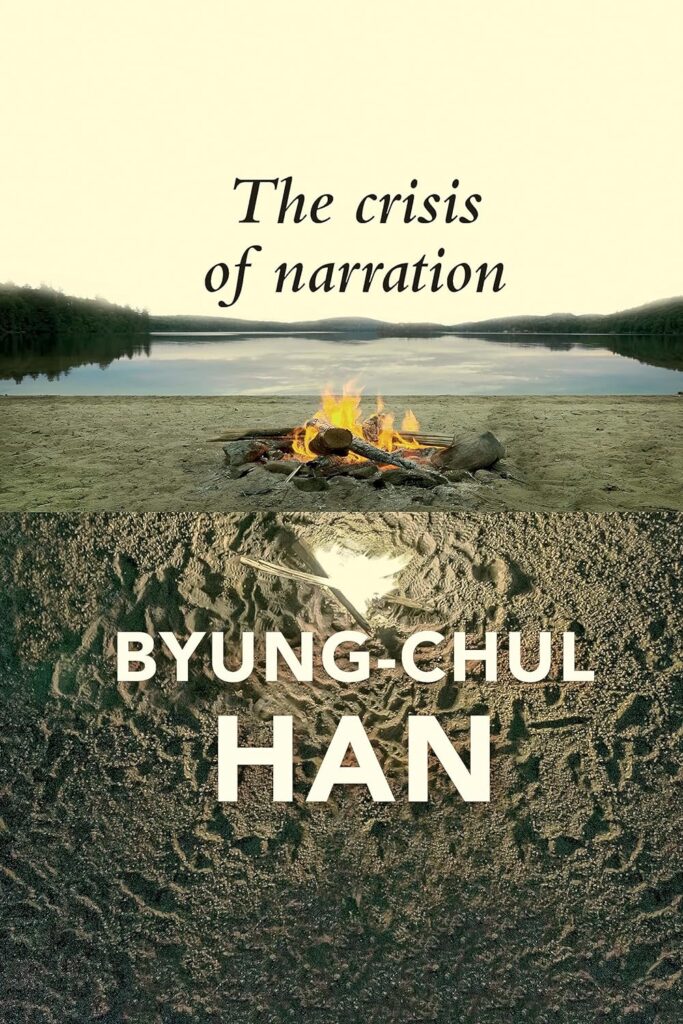That consummate political realist and Yes, Minister character Sir Humphrey Appleby once remarked: “the less you intend to do about something, the more you have to talk about it.” Byung-Chul Han’s recent essay brought this line to mind, arguing that even as we are awash in a sea of “narratives,” we live in a “crisis of narration” (vii). The core conviction of the essay is embodied in the author’s distinction between “Narrative” or “Narration” and “storytelling/storyselling.” The latter, Byung-Chul argues, are ersatz narratives whose central purpose is to sell you something. That “something” could be a political candidate, cultural cachet, or consumer goods, but storytelling inevitably becomes “storyselling.”
When I was a kid, I remember being suspicious that Al Gore’s flannel shirt was a component of the narrative sales pitch for his political campaign in Tennessee. More recently, here in rural Montana, I asked my students to imagine that they were running for office on a fiscal responsibility theme and whether the “optics” would be better if you drive to your far-away campaign stops in a Prius or a 1-ton pickup. The Prius could be seen as empirical evidence of your sincere commitment to not waste taxpayer money. But, my students plausibly pointed out, that wouldn’t fit the overall “that guy is one-of-us” narrative; in Byung-Chul’s lingo, your pickup-driving political opponent would have an easier time “storyselling.” To quote: “’Stories sell’ means, in effect, ‘emotions sell’” (67). And in rural Montana, feelings that the state is being over-run with Prius-driving liberal weenies are highly likely to override what good sense might tell us: that anybody with the guts to campaign in Montana in a Prius might actually mean it when they discuss frugality with taxpayer money. I say this as the owner of a squarebody ’89 Chevy big block, thus, I hope, preserving my “cred.”
So much for “storyselling.” When Byung-Chul discusses Narrative, by contrast, he generally means a story that defines some “closed order” of being (ix). So for Christians, in Byung-Chul’s sense, the Biblical narrative is a closed order, in that we know where we come from, we hope we know where we’re going, and we know “what it all means” at some basic level, even if some items such as the problem of evil remain thorny. So capital “N” narratives provide meaning, they orient us in some particular non-consumer direction in life, they close off some possibilities while prescribing others, and so on. I recently read a four-volume history of Christendom and its demise, which reminded me of the original meaning of “orientation”: facing East, Christians “orient” both their churches and their lives, towards the grand Narrative of salvation.[1] So Byung-Chul’s Narratives can create real community where “storyselling” creates only ephemeral communities organized around perpetual consumption, what he elsewhere terms “swarms.” I can think of no better illustration of this latter point, than a line from the theologian David Bentley Hart, who, with his usual panache, argued that:
Here one may cultivate a private atmosphere of “spirituality” as undemanding and therapeutically comforting as one likes simply by purchasing a dream catcher, a few pretty crystals, some books on the goddess, a Tibetan prayer wheel, a volume of Joseph Campbell or Carl Jung or Robert Graves, a Nataraja figurine, a purse of tiles engraved with runes, a scattering of Pre-Raphaelites prints drenched in Celtic Twilight, an Andean flute, and so forth, until this mounting congeries of string, worthless quartz, cheap joss sticks, baked clay, kitsch, borrowed iconography, and fraudulent scholarship reaches that mysterious point of saturation at which religion has become indistinguishable from interior decorating. Then one may either abandon one’s gods for something new or bide with them for a time, but in either case without any real reverence, love, or dread.[2]
All this brings me to a crucial way in which Byung-Chul’s essay applies to the basic Front Porch Republic project. I’ll take it as given that Narrative is significant, witness the controversies over the 1619 Project, for instance. I have my own opinions on whether that was an attempt at capital “N” Narrative or an episode of “storyselling;” you have yours, no doubt. I’d argue, though, that there is a certain narrative schizophrenia contained in Porcherism, and I can see The Crisis of Narration as useful in thinking that problem out. I detect at FPR a tension between two narratives, in Byung-Chul’s sense:
Narrative A is both realist and emotional: this is the Narrative that says the world is probably doomed; let’s hole up, get as close to homesteading as we can, and when the apocalypse arrives, we’ll get a beer and a lawn chair and watch, knowing that we spent our last years readings good books, growing a good garden (or in my 90-day growing season, at least attempting to do so), and congratulating ourselves that we did something better with our lives than fulfill the old Onion headline which read: “New Device Desirable, Old Device Undesirable.” Narrative B, on the other hand, contains a bit more Voltairean optimism in its sense of the scope of the “garden” we want our lives to cultivate. Most of us would like to prevent or at least reduce the instances of “radioactive trash mountains,”[3] and occasionally we do get up out of our lawn chairs from Narrative A and attempt to Do Something about the sorry state into which our worlds have gotten themselves.
So, of what story is localism part? Tragedy? Here, are we trying to live more humanly and humanely on our way to some Sophoclean end? Alternately, do we inhabit a Comedy, like Sam Elliot’s closing monologue in The Big Lebowski? Sometimes we cry, sometimes we laugh, but in the long run, it looks like we can count on the bemusing and indefinite continuation of “the whole durned human comedy”?[4] Or, is it possible that the proper muse of localism, in our time and places, emerges from a creative tension between these two Narratives? I’m still considering how to avoid turning localism into some consumable species of position-taking, as in Byung-Chul’s observation that
When certain goods are embellished with moral narratives such as ‘fair trade’, even morality becomes consumable. The moral narrative becomes information, and is sold and consumed as a product’s distinguishing feature. Moral consumption, mediated by narratives, increases only our own sense of self-worth. Through these narratives, we refer not to a community that is to be improved, but only to our own egos (65).
This brings me to what I’d regard as the central weakness of the book. Byung-Chul’s argument that a true political community (for example) can’t exist when the individual ego reigns supreme, seems true on its face. However, the proposed alternative is both so risible and so briefly stated—it takes up less than two pages of the book—that charity prompts me to put it down as a an afterthought that should be taken as seriously as the brief space the author devotes to it. Byung-Chul earlier posited that “Narration is a concluding form. It creates a closed order that founds meaning and identity” (ix, emphases in original). However, towards the end of the essay, he argues that “modern societies can create dynamic narrative communities that allow for change,” he criticizes “conservative” and “nationalist” critiques of “liberal permissiveness,” and suggests that there “are also inclusive narratives that do not cling to a particular identity.” Kant’s Perpetual Peace (1795) and the romantic poetry of Novalis serve as his examples; Byung-Chul envisions a true “world community” that rejects exclusionary “narratives of identity” (see 63-64, all emphases in original). This is, to put it mildly, trying to have one’s cake and eat it too. You can have a Narrative community with some kind of epistemic closure that defines “We” and (by implication) “They,” or you can have dorm-room dreams of utopia. You can’t have both.
Byung-Chul, presumably, wants to avoid community-defining Narratives that lead to hostility and violence, and this is all to the good. Perhaps his background as a Korean now living in Germany provides a couple of relevant historical contexts for his defense of what seems to me to be fatally indeterminate narratives. However, his alternative will inevitably promote and perpetuate the focus on identity that he criticizes as detrimental to community as defined by shared story. The myth of a “citizen of the world” is just that, and if I may be so bold, those individuals I’ve known who performatively bill themselves as such have consistently been some of the most unpleasant individuals I’ve known in my four decades and change.
So, I read The Crisis of Narration with a mix of interest and exasperation. Byung-Chul is surely right that a society based on a shallow identitarianism is no society at all. However, prizing the local, conserving the unique, and appreciating “the way we do things around here” is not incompatible with a commitment to living in peace with one’s neighbors whose Narrative sense of the world is different than mine. Some years ago, the historian Christopher Shannon published a book whose title, A World Made Safe for Differences sums up the problem here, I think. Byung-Chul is committed to the notion that there is some non-transcendent, global, We-making Narrative that we can all find ourselves within. If such a unicorn exists, I’ll need more than two pages’ worth of convincing. Count me rather, with Shannon’s concluding argument which has worn well: “[t]he fostering of local institutions, rooted in distinct, particular traditions, promises the most meaningful alternative to both the religious intolerance of the past and the secular intolerance of the present.”[5] Disagreements aside, however, Byung-Chul’s argument remains a valuable one: the cultures of consumption that rule the modern world are death to the cultures of community that give life meaning. If the book prompts more of us to think more carefully about how narrative structures contribute to this state of affairs, then it will have served a valuable purpose.
Image via Flickr
-
See in particular, volume one, John Strickland, The Age of Paradise (Chesterton, IN: Ancient Faith Publishing, 2019) ↑
-
David Hart. Atheist Delusions: The Christian Revolution and Its Fashionable Enemies (New Haven: Yale University Press, 2009), 23-24. ↑
-
Front Porch Republic. “Is a Radioactive Trash Mountain Coming to Town?” https://www.frontporchrepublic.com/2024/04/is-a-radioactive-trash-mountain-coming-to-town/ ↑
-
Youtube. “The Big Lebowski (1998) – Closing Scene,” https://www.youtube.com/watch?v=Nf8Qa50VEX8 ↑
-
Christopher Shannon, A World Made Safe for Differences: Cold War Intellectuals and the Politics of Identity (Lanham, MD: Rowman & Littlefield, 2001), 136. ↑






6 comments
Casey Spinks
Byung-Chul Han’s prognoses are almost as befuddling as his diagnoses are compelling. Seems to be the case with his latest, as you write.
In ‘Disappearance of Rituals’, he suggests the outright self-lessness of contemporary Japanese ritual—treated by him almost as a sort of totally surface-level aestheticism—as a possible solution to late modern subjectivism.
Surely we could all learn to live more on the surface of things, and do so as a way to counteract neoliberal subjectivity. But dandyism, and the kind fostered in one of the most capital and work driven cultures on the globe?
Thanks for the review!
Adam Smith
Just before I read your piece I was teaching Ursula Le Guin’s The Dispossessed, and there’s a passage we discussed that might be relevant here. Not sure HOW its relevant, exactly – just a inkling I have. For what it’s worth:
“Fulfillment, Shevek thought, is a function of time. The search for pleasure is circular, repetitive, atemporal, The variety seeking of the spectator, the thrill hunter, the sexually promiscuous, always ends in the same place. It has an end. It comes to the end and has to start over. It is not a journey and return, but a closed cycle, a locked room, a cell. Outside the locked room is the landscape of time, in which the spirit may, with luck and courage, construct the fragile, makeshift, improbable roads and cities of fidelity: a landscape inhabitable by human beings.
It is not until an act occurs within the landscape of the past and the future that it is a human act. Loyalty, which asserts the continuity of past and future, binding time into a whole, is the root of human strength; there is no good to be done without it.”
Something about that contrast between the “circular, repetitive, atemporal” (the kind of storyselling anti-narrative you get scrolling twitter) and the “landscape of time,” where people make promises and build worlds, a landscape of meaningful narrative, of storytelling – I dunno, maybe that’s getting at something about our moment and FPR’s role in it . . .
Aaron
I’d not read that book, Adam, so thanks for mentioning it. Haven’t read Le Guin since high school, I’ll check that out. The qoute you mention reminds me of one of my favorite Rieff lines–I’ve probably quoted him here, that since the late 19th century, the “only answer to ‘what for?’ is ‘more’.” A similar point I think, about how living in the Now locks us into an unfulfilling, repetitive cycle.
Aaron
Brian D. Miller
Thanks for the reminder, Adam, to read more Le Guin.
Brian
Thank you for writing.
I don’t think your Narrative A has existed in a meaningful way for a decade or more–no one talks about “Peak Oil”, etc., anymore, and the associated doomerism, whether environmental, economic, or otherwise, isn’t really a thing here anymore.
And I’d suggest that Narrative B has never really existed, in fact the lack of any sort of coherent actionable advocacy is probably a big part of why the site’s never seen any growth in influence.
Aaron
Brian:
In your view, how would we know, if FPR was in fact having Influence of some type? Seems to me like the sorts of ideas bandied around here, are also the kind that tend not to get noticed, almost by definition.
Aaron
Comments are closed.